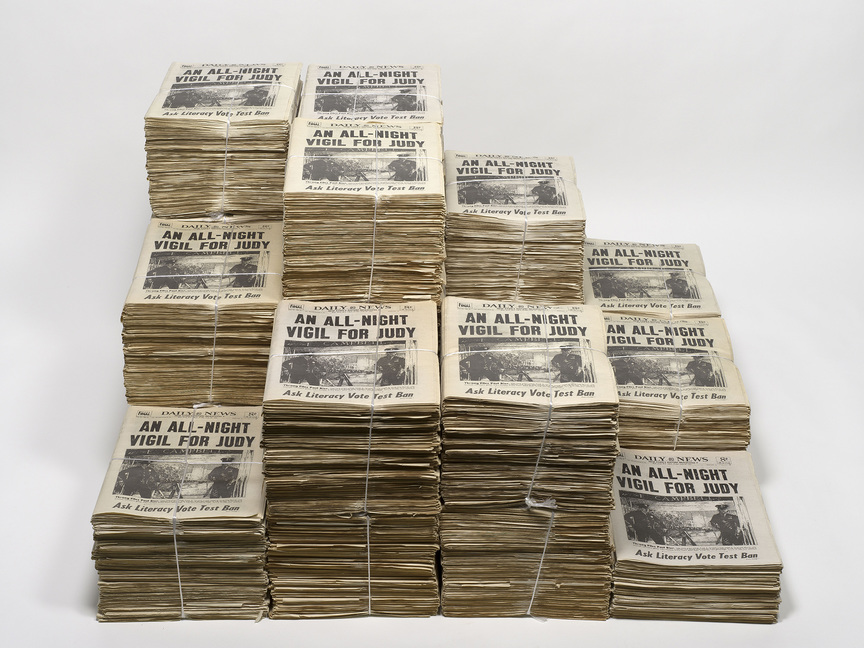-
From Current Issue
-
- Editor’s Letter Fire in the Heart
- Reviews I Gusti Ayu Kadek Murniasih
- Reviews 11th Seoul Mediacity Biennale: “One Escape at a Time”
- Dispatch Networked China
- One on One Monira Al Qadiri on Yukio Mishima
- Essays The rise of independent art spaces in pandemic-era Shanghai
- Features Tuan Andrew Nguyen
- Table of Contents
- Web Exclusives
- Archive
- Subscribe

R
E
V N
E
X
T
Installation view of “Work, Work, Work,” at Queensland Art Gallery | Gallery of Modern Art (QAGOMA), Brisbane, 2019–20. All images courtesy QAGOMA.
If recent editorials are to be believed, society now values public displays of productivity as much as conspicuous wealth. To be busy is to be important. The inverse of this fetishization of labor among the elites is the brutal reality faced by the remaining 99%⎯where employment is increasingly precarious, transient, disempowering, and under attack from robotic innovation. “Work, Work, Work” featured global art drawn from the Queensland Art Gallery | Gallery of Modern Art collection, and considered how labor informs our social, political, and technological lives, as well as the production and reception of art. The curator, Ellie Buttrose, continued to demonstrate her skill at engendering insightful, cross-cultural dialogue through unlikely combinations.
In the first space, exhibits reflected on cumulative power through groupings of people and objects. For About 1,000 copies of The New York Daily News on the day that became the Stonewall Riot copied by hand from microfilm records (1997), Mathew Jones replicated the newspaper from June 27, 1969, in its entirety, arranging the bundled copies on a low plinth. As the title notes, the date’s significance lies in its insignificance as the day prior to the first brick being thrown at New York City’s Stonewall Inn—now considered as having kickstarted the modern LGBTQIA+ rights movement. Other pieces displayed in this room include Zhang Huan’s To add one meter to an anonymous mountain (1995)⎯a six-minute video of performers stacking their naked bodies on top of a peak⎯and Work team contest (2009), a vast Social Realist mosaic from North Korea’s Mansudae Art Studio, one of the country’s changjaksa (official artist studios). The latter commends the efficiency of steel foundry workers who had surpassed their productivity targets, their faces beaming amid a celebratory brass band. The meeting of these pieces generated an exhilarating tension, bending the meaning of working together across each action: Jones’s isolated toil in ode to historic, collective action; the minute yet somehow monumental gesture of Zhang’s performers; the mosaic’s politicized depiction of labor, produced in an actual factory of state propaganda. The role of the worker flips subtly across each.
Mass production frames the next space, keying into its influence on minimal and conceptual practices since the 1960s. Haegue Yang’s installation of Venetian blinds Sol LeWitt Upside Down – Open Modular Cubes (Small), Expanded 958 Times (2015) is a humorous take on the quintessential conceptualist’s modular structures. Nearby, John Baldessari’s video I am making art (1971) shows the artist repeatedly verbalizing the titular phrase and enacting repetitive gestures. Yang’s standardization and Baldessari’s dematerialization, almost half a century apart, reflect on the ongoing relevance of these particular artistic modes to notions of labor. In overt opposition to Baldessari’s dematerial gesture, Māori artist Michael Parekowhai’s imposing Home Front (2015)—a vast wall of colored blocks that bisected the exhibition—encourages a maximalist material reflection on the legacy of minimalist pioneers such as Donald Judd.
The final two sections, on the other side of a door at Home Front’s center, explored the built environment, and the precarity of existence within a globalised economy. The global financial capital of London serves as the setting for Tsui Kuang-Yu’s video The Shortcut to the Systematic Life: City Spirits (2005), in which the artist’s “work” takes the form of playful urban interventions. Tsui is seen bowling in public parks with pigeons acting as reluctant stand-ins for pins; waving a chequered racing flag at cars stopped in front of traffic lights; or practicing his golf swing from grassed median strips. Leisure can be work and wield political potency too, subverting structures and spaces that condition our livelihoods.
Installation view of MICHAEL PAREKOWHAI’s Home front, 2015, aluminium, polyurethane paint on two walls, 420 × 2295 cm each, at “Work, Work, Work,” QAGOMA, Brisbane, 2019–20.
It seems obvious to state that contemporary artistic labor is multifaceted; the strength of “Work, Work, Work” lay in its invitation to examine these variances across cultures. Simultaneously, it encouraged important reflection on the threatened value of labor—artistic or otherwise—at present, as well as the incisive, unquantifiable contributions of art.
Tim Riley Walsh is ArtAsiaPacific’s Brisbane desk editor.
“Work, Work, Work” is on view at Queensland Art Gallery | Gallery of Modern Art, Brisbane, until July 19, 2020.
To read more of ArtAsiaPacific’s articles, visit our Digital Library.


















